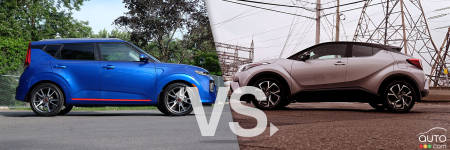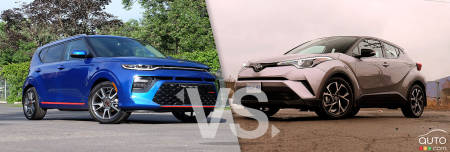In an age of cookie-cutter models, especially when it comes to SUVs, many people yearn for a vehicle that stands out visually. These are the folks we’re addressing today. With its square design housing a beautiful interior space, the Kia Soul has steadily increased in popularity in recent years. Even the new model just arriving for 2020 still remains closely related to the original model. The Toyota C-HR is equally striking, though it sports strikingly different design features. In both cases, the styling doesn’t please everyone but in both cases, they are undeniably very different.
2019 Kia Soul
The Soul is the only vehicle that has survived the square-box trend, the one that produced the Nissan Cube, Scion xB and Honda Element, for example. Despite the fact that the basic design has barely changed for two generations, Kia's most practical little car still doesn’t look like anything else on the road. Maybe there’s room for only one of these in the market…
This year, Soul's list of basic features gets a bit longer with the addition of a 5.0-inch multimedia touchscreen (still too small in our view) with built-in back-up camera and automatic headlamps.
Our review of the 2020 Kia Soul
Specifications of the 2019 Kia Soul
Specifications of the 2020 Kia Soul
For the 2019 model, the choice of engines starts with a 1.6L 4-cylinder unit producing 130 hp and 118 lb-ft of torque, this in the LX version. EX models are powered by a 2.0L engine delivering 161 hp and 149 lb-ft, while the SX Turbo versions feature a 1.6L turbo engine delivering 201 hp and 195 lb-ft of torque. Non-turbo models come standard with a 6-speed automatic transmission, while the turbo uses a 7-speed double clutch transmission.
For 2020, 4-cylinder engine making 147 hp combined with a CVT transmission is the only unit on offer.
Available only with front-wheel drive, the Soul is in the same boat on this front as the Toyota C-HR, and the Nissan Kicks for that matter. Equipment-wise, Kia generally does things well and here it’s no exception. The basic LX model includes, among other things, a wiper de-icer, a USB input, a height-adjustable driver's seat, air conditioning, power windows, power heated exterior mirrors and keyless entry.
The EX version replaces the 16-inch steel wheels on the LX with 17-inch alloys and adds heated front seats, a heated steering wheel and cruise control. EX models comes with leather seats (option), power driver seat, blind spot detection with rear cross traffic alert and auto-dimming rearview mirror.
The EX Tech version features HID headlights, ventilated front seats, adaptive cruise control, automatic emergency braking, forward collision warning and lane departure warning.
The SX Turbo adds sport suspension and 18-inch wheels. A tech package also includes LED fog lights, enhanced audio system and navigation.
Long live the turbo
You can easily imagine that the turbo model is by far the most interesting to drive. Kia will however have to address the issues of turbo lag and torque steer when you step on the gas pedal. For the rest, the surplus of energy provided by the turbocharger and the impressive 7-speed sequential transmission give excellent results. The basic engine is to be avoided, it is frankly uninteresting. If you want an entry model, go for the 2.0L engine, which provides the minimum you’ll need.
Conclusion
For those looking for a distinctive, friendly and practical ride, the Soul meets all these criteria and accommodates more than a small family. Even if its price is higher, the turbo version is the most pleasant to drive. Note, however, that this version is no longer available in Canada for 2020.
2019 Toyota C-HR

Originally designed for Toyota’s “youth-oriented” Scion division, the C-HR came on the market just as the Japanese automaker closed the division. Which is how and why the C-HR became a Toyota. This explains the offbeat styling of the model that stands out in the category, and in the Toyota lineup for that matter.
Several trims
Changes this year include a new LE model that lowers the base price by $1,000 in comparison with last year. There are also some new standard features, including a windshield defroster, Toyota's Entune 3.0 infotainment system (which now supports the Android Auto), and a larger 8.0-inch touchscreen to control these infotainment functions.
The XLE version adds Entune Audio 3.0 Plus and the new Limited version features leather seats, ambient interior lighting and rain-sensing windshield wipers.
Our review of the 2019 Toyota C-HR
Specifications of the 2019 Toyota C-HR
Under-powered
While the unusual and playful styling does it part to please at least a certain sub-group of consumers, difficult to say the same about the C-HR’s performance. The 2.0L 4-cylinder engine develops 144 hp and 139 lb-ft of torque, with powert sent to the front wheels (there is no 4WD option) via a continuously variable transmission (CVT). While the power matches that offered elsewhere in the segment of small SUVs, the CVT box takes all the pleasure of driving away.
On the road
Built on a new rigid platform with a low centre of gravity, this Toyota is closer to a car that looks like an SUV. Suspension configurations (McPherson front and double-wishbone rear) are the same as in sedans. The C-HR is thus nervous and precise on the road, and its small size allows it to scoot nimbly around city streets.
You can choose optional 18-inch wheels on their own or with the Premium Package, which also includes the Smart Key system with push-button start, power folding mirrors with lamps that project the C-HR logo on the floor, the blind spot monitoring and the rear cross-traffic alert system.


Conclusion
While the model displayed good driving qualities, we found that the C-HR was underpowered and slow to react. The cabin is a little noisy and the rear seats have tiny, tall windows; it's hard for adults to see very much when sitting in back. Toyota's safety features, however, are very good and include pedestrian detection, lane departure warning and the standard Toyota Safety Sense P suite on all C-HRs.

Advantage Kia Soul
For its guarantee and its more generous basic equipment, you have to go to Kia. Kia also offers a wide range of engines, including the 1.6L turbo engine that is the most interesting to drive. Soul is also the one that offers the best interior layout and the quietest ride.
Advantage Toyota C-HR
Toyota is well-covered in terms of safety with the standard Safety Sense P suite, ahead in this respect of Kia’s Soul, where you have to go with the SX version to benefit from an equivalent level of safety systems. Toyota is also known for its reliability and the C-HR will probably retain a better resale value after a few years.
Similarities
Both models have distinctive styling, good interior space (though the boxier Soul does have a slight advantage here), comparable prices and both are available with front-wheel drive only.
Verdict
Honestly, both models offer pros and cons. Our vote goes to the Soul for the superior driving pleasure delivered by the 1.6L engine and its more-generous offering of equipment. That said, the C-HR is also a good choice.
Note that our comparison is based on the 2019 version of the Soul, but that the new 2020 edition is now available at dealerships.

2019 Kia Soul
We like
Unique styling
1.6L turbo engine
UVO system
We like less
Basic engine pretty blah
Lazy 6-speed automatic transmission
So-so fuel consumption
Only available in front-wheel drive
2019 Toyota C-HR
We like
Unique styling
Solid chassis
Good fit and finish
We like less
Only available in front-wheel drive
Underpowered engine
No Apple CarPlay or Android Auto
Noisy cabin

Specifications
| ... | 2019 Kia Soul | 2019 Toyota C-HR | |
| Transmission | auto 6, seq 7 | CVT | |
| Drivetrain | FWD | FWD | |
| 1.6L | 2.0L | ||
| Fuel consumption (city) | 9.4L/100 km | 8.7L/100 km | |
| Fuel consumption (highway) | 7.8L/100 km | 7.5L/100 km | |
| 2.0L | |||
| Fuel consumption (city) | 9.5L/100 km | ||
| Fuel consumption (highway) | 7.8L/100 km | ||
| 1.6L T | |||
| Fuel consumption (city) | 9.1L/100 km | ||
| Fuel consumption (highway) | 7.7L/100 km | ||
| Engine | 1.6L | ||
| Type | Gas | Gas | |
| Output | 130 hp | 144 hp | |
| Torque | 118 lb-ft | 139 lb-ft | |
| Cylinders | 4 | 4 | |
| 2.0L | |||
| Type | Gas | ||
| Output | 161 hp | ||
| Torque | 149 lb-ft | ||
| Cylinders | 4 | ||
| 1.6L T | |||
| Type | Gas | ||
| Output | 201 hp | ||
| Torque | 195 lb-ft | ||
| Cylinders | 4 | ||
| Capacities | |||
| Cargo Space | 532 l, 1402 l | 538 l, 1031 l | |
| Fuel tank | 54 l | 53 l | |
| Dimensions | |||
| Length | 4140 mm | 4350 mm |
| ... | 2019 Kia Soul | 2019 Toyota C-HR | |
| Width | 1800 mm | 1797 mm | |
| Height | 1600 mm | 1565 mm | |
| Wheelbase | 2570 mm | 2640 mm | |
| Warranty | 5 yrs/100,000 km | 3 yrs/60,000 km | |
| Price | $20,095 to $30,095 | $23,675 to $28,775 |






